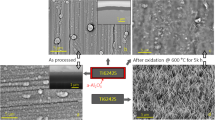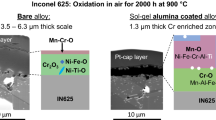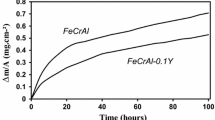Abstract
Nickel-base alloys are used in high-temperature applications due to their favorable mechanical properties and oxidation behavior. Some of these alloys are designed to form a protective aluminum oxide scale to achieve oxidation resistance. In some oxidizing environments, water vapor is also present. However, only limited data are available regarding the effects of water vapor on the oxidation behavior of alumina-forming alloys (“alumina formers”), especially for early stage oxidation. Moreover, the currently available mechanisms for dry oxidation of alumina formers propose different pathways leading up to the final morphology of the oxide scale. In this study, the early oxidation behavior of an alumina former (UNS N07214) in dry and humid air was conducted at 1000°C for different exposure times (1 min to 100 h). Detailed examination of the surface of this alloy reveals that an alumina film is initially (1–10 min) formed in both dry and humid conditions. For longer exposure times (1–10 h), this initial alumina film is disrupted by the formation of chromia and nickel oxide/nickel chromite islands in both cases. Subsequently, for 100 h exposures, a continuous alumina scale is re-established. A mechanism to explain the observed phenomena is proposed.








Similar content being viewed by others
References
T.M. Pollock, and S. Tin, J. Propul. Power 22, 361. (2006).
G.W. Meetham, J. Mater. Sci. 26, 853. (1991).
S.R.J. Saunders, M. Monteiro, and F. Rizzo, Prog. Mater. Sci. 53, 775. (2008).
M.C. Maris-Sida, G.H. Meier, and F.S. Pettit, Metall. Mater. Trans. A 34A, 2609. (2003).
C.S. Giggins, and F.S. Pettit, J. Electrochem. Soc. 118, 1782. (1971).
T.J. Nijdam, L.P.H. Jeurgens, and W.G. Sloof, Acta Mater. 53, 1643. (2005).
L. Hu, D.B. Hovis, and A.H. Heuer, Oxid. Met. 73, 275. (2010).
N. Ury, A. Wagner, E. Quach, A. Gutierrez, V. Deodeshmukh and V. Ravi, Corrosion 2019, Paper No. C2019-13520 (Houston, TX: NACE, 2019)
E. Opila, J. A. Lorincz, J. J. Demange, Proc. Electrochem. Soc., 67 (2004).
X.J. Zhang, S.Y. Wang, F. Gesmundo, and Y. Niu, Oxid. Met. 65, 151. (2006).
J. Jedlinski, Defect Diffus. Forum 289, 385. (2009).
F.H. Stott, G.C. Wood, and M.G. Hobby, Oxid. Met. 3, 103. (1971).
W.E. Boggs, J. Electrochem Soc. 118, 906. (1971).
K.M.N. Prasanna, A.S. Khanna, R. Chandra, and W.J. Quadakkers, Oxid. Met. 46, 465. (1996).
J.L. Gonzalez Carrasco, P. Adeva, and M. Aballe, Oxid. Met. 33, 1. (1990).
X. Yang, X. Peng, and F. Wang, Corros. Sci. 50, 3227. (2008).
S. Hayashi, S. Narita, and T. Narita, Oxid. Met. 74, 33. (2010).
P. Berthod, L. Aranda, S. Mathieu, and M. Vilasi, Oxid. Met. 79, 517. (2013).
E. Opila, Mater. Sci. Forum 765, 461. (2004).
B. Chattopadhyay, and G.C. Wood, Oxid. Met. 2, 373. (1970).
G. Zhou, Appl. Phys. Lett. 94, 1. (2009).
J.G. Goedjen, and D.A. Shores, Oxid. Met. 37, 125. (1992).
F.A. Golightly, G.C. Wood, and F.H. Stott, Oxid. Met. 14, 217. (1980).
D. Li, J. Alloys Compd. 692, 427. (2017).
Acknowledgements
The authors would like to acknowledge technical assistance from Kentaro Lunn, Harjot Singh, Eric Quach, Ananda Gutierrez, Ulus Ekerman, Joey Tulpinski, and Anan S. Hamdan (Cal Poly Pomona). The authors gratefully acknowledge financial support from Ms. Sylvia Hall, the LA section of NACE International Western States Corrosion Seminar, Western Area of NACE International, the NACE Foundation, California Steel Industries Inc., the Boeing Company, Chevron Corporation and the Southern California Chapter of the Association for Iron & Steel Technology. The SEM images and EDS analysis were made possible through an NSF MRI grant DMR-1429674.
Author information
Authors and Affiliations
Corresponding author
Ethics declarations
Conflict of interests
On behalf of all authors, the corresponding author states that there is no conflict of interest.
Additional information
Publisher's Note
Springer Nature remains neutral with regard to jurisdictional claims in published maps and institutional affiliations.
Supplementary Information
Below is the link to the electronic supplementary material.
Rights and permissions
About this article
Cite this article
Ury, N., Wagner, A., Deodeshmukh, V. et al. Oxide Scale Development in a Ni-16 Cr-4.5 Al Alloy for Short Exposure Times. JOM 73, 3974–3987 (2021). https://doi.org/10.1007/s11837-021-04967-6
Received:
Accepted:
Published:
Issue Date:
DOI: https://doi.org/10.1007/s11837-021-04967-6




